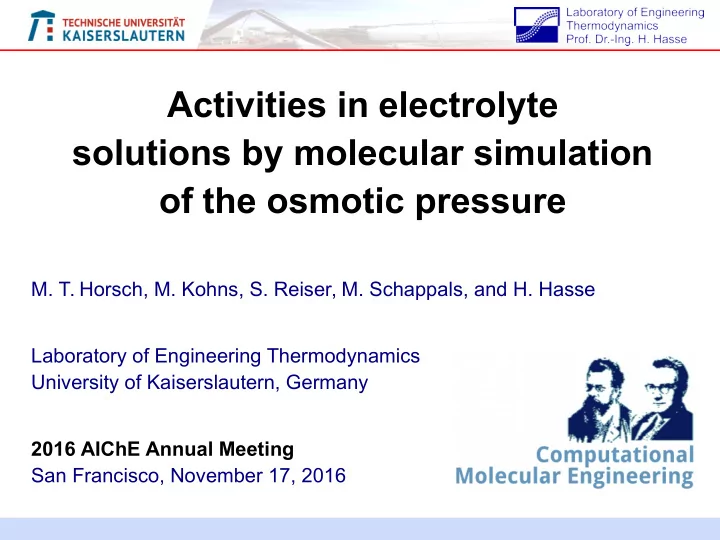

Activities in electrolyte solutions by molecular simulation of the osmotic pressure M. T. Horsch, M. Kohns, S. Reiser, M. Schappals, and H. Hasse Laboratory of Engineering Thermodynamics University of Kaiserslautern, Germany 2016 AIChE Annual Meeting San Francisco, November 17, 2016
Osmotic pressure for activity of solvents In a dense liquid, it is hard to com- pute the chemical potential (or acti- vity) by inserting test particles. OPAS method: Compute the osmo- tic pressure from the force acting on a virtual semipermeable membrane. External harmonic potential constraining the solute inside. No external potential for the solvent. Π = P in – P out Nov 17, 2016 Martin Horsch, Maximilian Kohns, Steffen Reiser, Michael Schappals, and Hans Hasse 2
Osmotic pressure for activity of solvents Step 1: Pseudo- NPT run, where the barostat is adjusted to regulate P out . Step 2: NVT simulation. http://www.ms-2.de/ OPAS method: Compute the osmo- tic pressure from the force acting on a virtual semipermeable membrane. Solvent activity (Raoult normaliza- tion) from osmotic pressure: in = − ∫ P in pure ≈ −Π v solv P pure RT ln a solv dP v solv out Density and compressibility of the pure solvent are easy to compute. Nov 17, 2016 Martin Horsch, Maximilian Kohns, Steffen Reiser, Michael Schappals, and Hans Hasse 3
Validation of the OPAS method Test case: Mixture of argon (LJ) and oxygen (2CLJQ). Ar is treated as solvent and moves freely through the simulation volume. The solute O 2 is confined by the membranes to the inner compartment. argon T = 140 K oxygen Nov 17, 2016 Martin Horsch, Maximilian Kohns, Steffen Reiser, Michael Schappals, and Hans Hasse 4
Validation of the OPAS method Test case: Mixture of argon (LJ) and oxygen (2CLJQ). Osmotic pressure from force acting on the membranes: 6.33 ± 0.06 MPa. Osmotic pressure from difference between compartments: 6.1 ± 0.2 MPa. argon T = 140 K oxygen Nov 17, 2016 Martin Horsch, Maximilian Kohns, Steffen Reiser, Michael Schappals, and Hans Hasse 5
Aqueous alkali halide salt solutions: Model Molecular models: Ions Water (here: SPC/E) - - 1 Lennard-Jones 1 Lennard-Jones + + 1 point charge 3 partial charges Li + Na + K + Rb + Cs + F – LiF NaF KF RbF CsF Cl – LiCl NaCl KCl RbCl CsCl Br – LiBr NaBr KBr RbBr CsBr I – LiI NaI KI RbI CsI Nov 17, 2016 Martin Horsch, Maximilian Kohns, Steffen Reiser, Michael Schappals, and Hans Hasse 6
Adjusting the model to experimental data Density ratio “solution : pure” Self-diffusion coefficients T = 298 K P = 100 kPa m Lennard-Jones size parameter σ Lennard-Jones energy parameter ε Nov 17, 2016 Martin Horsch, Maximilian Kohns, Steffen Reiser, Michael Schappals, and Hans Hasse 7
Validation: Non-aqueous solutions Density of methanolic electrolyte solutions at T = 298 K and P = 1 bar: • Experimental data (this work) • Simulation Nov 17, 2016 Martin Horsch, Maximilian Kohns, Steffen Reiser, Michael Schappals, and Hans Hasse 8
Water activity in electrolyte solutions Validation of OPAS simulation results T = 298.2 K against literature data for aqueous P out = 1 bar NaCl solution using ● the SPC/E water model, ● the Joung-Cheatham NaCl model. OPAS simulation results (this work) Correlation to present OPAS results Moučka et al. (sim.), SPC/E + JC Hamer and Wu (exp.) Nov 17, 2016 Martin Horsch, Maximilian Kohns, Steffen Reiser, Michael Schappals, and Hans Hasse 9
Salt activity coefficient in aqueous solution Chemical potentials of the solute T = 298.2 K and the solvent are related by the P out = 1 bar Gibbs-Duhem equation. Chemical potential of the salt expressed as activity coefficient (Henry normalization). OPAS (this work) Mester and Panagiotopoulos Moučka et al. Exp. Nov 17, 2016 Martin Horsch, Maximilian Kohns, Steffen Reiser, Michael Schappals, and Hans Hasse 10
Salt activity coefficient in aqueous solution Series of own models for ● alkali cations ● and halide anions, collectively adjusted to ● reduced solution densities ● and self-diffusion coefficients. Present simulation results Mester and Panagiotopoulos Validation against: Correlation to experimental data by Hamer and Wu Nov 17, 2016 Martin Horsch, Maximilian Kohns, Steffen Reiser, Michael Schappals, and Hans Hasse 11
Salt activity coefficient in aqueous solution Nov 17, 2016 Martin Horsch, Maximilian Kohns, Steffen Reiser, Michael Schappals, and Hans Hasse 12
Model reparameterization Revised σ (K + ) = 2.06 Å (before: 2.77 Å), σ (F – ) = 3.94 Å (before: 3.66 Å). T = 293 K p r e P = 1 bar revised model v i o u s m o d e l T = 298 K KF(aq) P = 1 bar For a specific combination of ions, the accuracy for the chemical potential can be improved without a loss in accuracy for the density. Nov 17, 2016 Martin Horsch, Maximilian Kohns, Steffen Reiser, Michael Schappals, and Hans Hasse 13
Conclusion In previous work of our group, LJ + point charge models of the alkali and halide ions were parameterized to the density of aqueous salt solutions. The models were validated against own experimental (density) data for non-aqueous solutions and for aqueous solutions at different conditions. By OPAS simulation with virtual semipermeable membranes, the influ- ence of salts on the activity of the solvent can be determined with a reduced effort, compared with methods based on particle insertion. Activity coefficients of the solute alkali halide salt can be obtained by Gibbs-Duhem integration. In some cases, the models agree well with experimental activity data. In other cases, the agreement can be improved substantally. Nov 17, 2016 Martin Horsch, Maximilian Kohns, Steffen Reiser, Michael Schappals, and Hans Hasse 14
Recommend
More recommend